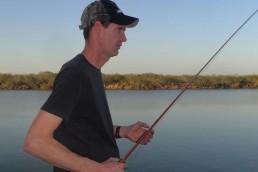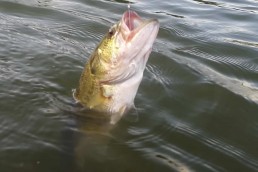Sight Fishing Largemouth Bass
SHARE THIS POST
During my teens, I cast 4-inch Ringworms to bass plainly in my view. The fishing felt a little odd, because most of my bass fishing involved casting to bass I couldn’t see. To pick them out visibly was unusual, but it was very productive. Nowadays, it feels as natural as any other way of going about bass. Sight fishing always involved ponds during my younger days, not lakes. To this day, 40 years later, I still find this sort of action lacking in larger waters. I do remember an early June exception when fishing a gin-clear reservoir, but the bass cruised 10-feet deep. Though I managed to sink worms in front of their eyes and hook up, it wasn’t the same phenomenon I have in mind.
If summer weather is sunny, stable, calm, and hot, it can happen. A recent lunch break resulted in one bass short of a dozen for me from a three-acre pond, all of them on 6-inch Chomper’s Shaky worms rigged weightless. Weeds and other cover lacking, I used a size 2 plain-shank hook tied directly to 6-pound mono with no weight added. Bass lazily sunned themselves just under the calm surface. After I approached them stealthily, they simply punched forward and engulfed worms presented a foot or two in front of them.
Lazy fish are hard to find
You won’t always find the bass stationary, however. Usually, they cruise slowly a foot or two under the surface in shallows— especially those of flats—anywhere from a foot to six or seven-feet deep. The challenge is to anticipate where worm and bass will meet. Giving the impression of a limbo state, the fish aren’t eager to go out of their way. You want that worm to slowly sink right in front of their eyes. Unlike the distance I managed to keep on that lunch break, sometimes bass will take a worm in plain view a few yards from where I stand. It’s as if they don’t notice my presence.
If you anticipate big bass in a pond that is weedy and/or filled with woody cover, carry an extra spool filled with 15-pound test braid. If do you see big ones, use it by tying two feet of 15-pound fluorocarbon directly to the braid by uni-to-uni splice. A 2/0 weedless inset hook keeps a 6- to 8-inch worm weed-free. Most of the time, however, the bass you can see will be on the small side. Once in a while, you’ll see one of them leap.
Are you enjoying this post?
You can be among the first to get the latest info on where to go, what to use and how to use it!
Find the flies, find the fish
That’s a clue to what this visible behavior is all about. Especially in ponds with lily pads or other aquatic vegetation penetrating the surface, damselflies hover and dip. Often confused with dragonflies, damselflies are delicate and have less outsized mandibles. They don’t fly as fast as dragonflies, so they’re relatively easy prey. The connection between this insect forage and why bass of up to about a pound swim near the surface on hot afternoons is clearly evident, but I believe there’s more to this behavior than I understand. Unfortunately, I haven’t further clues to offer besides stable, high pressure equaling lazy and visible bass.
An old adage states that when you find small fish, larger will stage behind them in deeper water. On some occasions, I’ve enjoyed steady action with bass of about a pound or so cruising two or three feet deep near additional depths of about 10 feet. By fishing that deeper water, I’ve scored better bass. Wearing polarizers is a good idea for any kind of sight fishing. Though I don’t recall if I wore a pair on an especially productive afternoon years ago, they wouldn’t have hurt. I witnessed an entire pod of three-pounders rise from clear depths to the six- and seven-foot level from behind smaller fish riled up by me fishing them. I did well with these big ones, too.
Fly casters might have a field day on cruising and basking bass while using damselfly imitations. Though I’ve always stuck to spinning rods and plastic worms, I would be pleased to hear about success on the fly. I wouldn’t bother with poppers under a scorching sun. I would use a slow-sinking streamer pattern. Maybe that’s just the ticket.
MWO
SHARE THIS POST
You may also like...
0 CommentsNight Fishing for Largemouth Bass on Cedar Lake
Did you enjoy this post?
You can be among the first to get the latest info on where to go, what to use and how to use it!
Bruce Edward Litton
MidWest Outdoors works with more than 200 outdoor experts each year, who contribute articles based on their areas of expertise. MidWest Outdoors magazine offers more fishing and hunting articles than any other publication!


